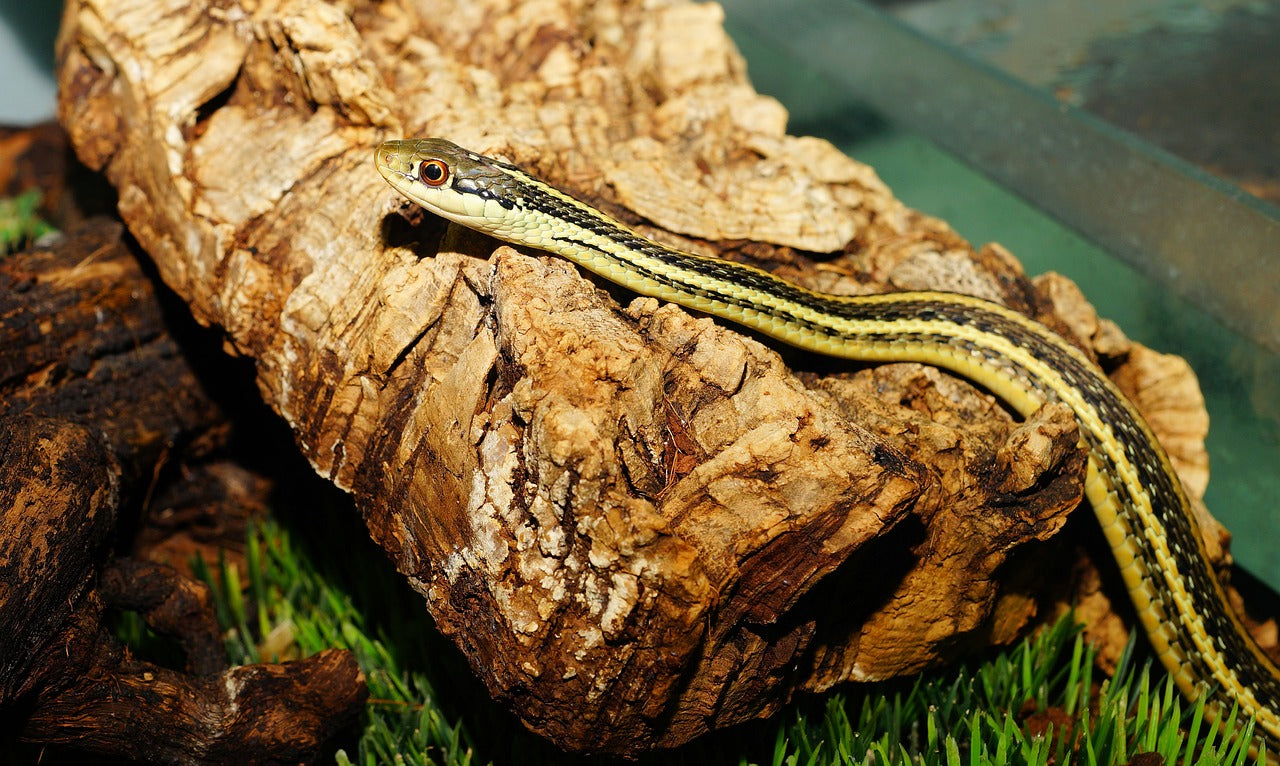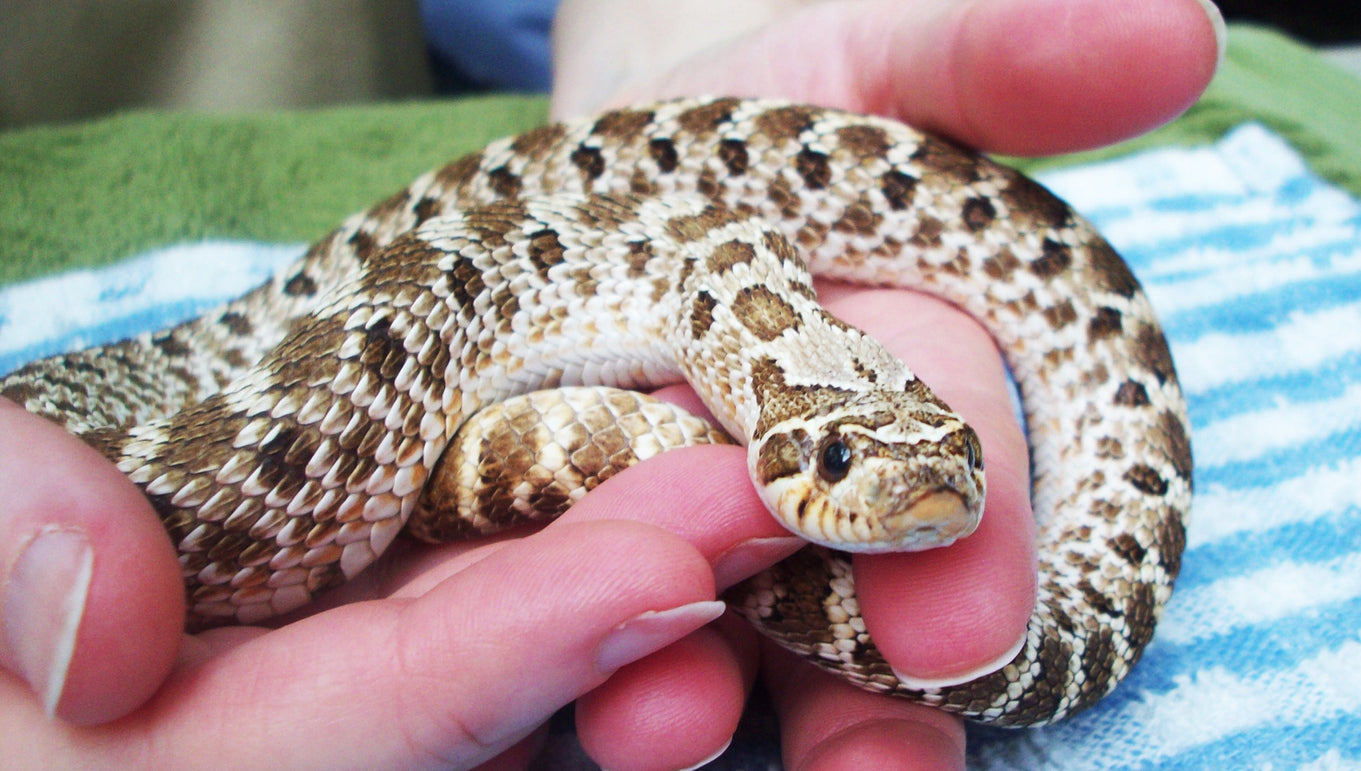Gopher snakes (Pituophis catenifer) are a group of medium to large, terrestrial, diurnal snakes native to the western half of the US, southwestern Canada, and northern Mexico. They can be found in a wide variety of habitats, including woodland, desert, shrubland, prairie, and grassland.
Gopher snakes can grow anywhere between 3.5’ to 7’, depending on subspecies. Coloring and pattern also tend to vary between subspecies, but they’re usually colored in earth tones, with dark blotches on a lighter base color. All have round pupils, keeled scales, and slender but robust bodies. They tend to hiss loudly and can rattle their tail against the ground — these traits combined with their appearance mean that they are often mistaken for rattlesnakes.
Although gopher snakes have a bad reputation for being aggressive, captive-bred individuals can actually be great beginner-level reptiles. With good care, they can live as long as 33 years!
Gopher snakes’ care requirements are generally fairly similar from species to species, however there are essential differences that should be noted. This care sheet should be used only as a general guide, and we strongly recommend doing research on your specific subspecies for best results.
Gopher snakes are very common in the US, but that does not mean it’s a good idea to capture one from the wild if you want one as a pet. Wild-caught snakes are often more stressed in captivity and often carry heavy parasite loads.
How much space do gopher snakes need?
A good starting point for the average gopher snake is a 48”L x 24”W x 24”H enclosure, but larger will be required for individuals over 6’ long. Gopher snakes are highly active when given the opportunity, so larger is always better.
Cohabitation (keeping multiple gopher snakes in one enclosure) is not recommended.
Do gopher snakes need UVB?
They can survive without it, but it’s still best practice to provide UVB lighting for optimal health and wellbeing. Gopher snakes are diurnal after all, so it’s likely that they are routinely exposed to sunlight in the wild. UVB gives snakes all of the vitamin D that their bodies need, stimulates better appetite and activity, and generally allows them to be healthier than they would be without.
Here are the best UVB bulbs for gopher snakes:
- Arcadia T5 HO Forest 6%
- Zoo Med T5 HO Reptisun 5.0
The UVB bulb should be housed in a reflective fixture (Arcadia or Vivarium Electronics) and placed on the same side as the heat lamp, half the length of the enclosure. Place the basking surface 11-13” below the bulb with mesh obstruction. UVB is blocked by glass and plastic, so you can’t give your snake UVB by placing its terrarium in front of an open window. Replace the bulb every 12 months to maintain optimal performance.
Lights should be on for 14 hours/day during summer and 10 hours/day during winter. This replicates seasonal light cycles, encouraging healthier hormonal rhythms and possibly better long-term health.
What basking temperatures do gopher snakes need?
Like other reptiles, gopher snakes are ectotherms, which means that they need a temperature gradient in their enclosure to help them regulate their metabolism and stay healthy.
Gopher snakes should have a basking surface temperature around 85°F directly under a heat lamp placed to the extreme right or left of the enclosure. On the other side of the enclosure, the temperature should be between 70-75°F. Measure temperatures with a digital probe thermometer placed on each side.
Provide heat for your gopher snake by imitating the sun with a cluster of at least two halogen heat bulbs placed on one side of the enclosure, positioned over the warm hide. The basking surface should be a large piece of flat stone for best results. Do not use ceramic heat emitters (CHEs), heat mats, red bulbs, or blue bulbs, as these are not as effective. If the bulbs are too cool, you need a higher wattage. If too warm, use a lamp dimmer.
Heating should be turned off at night.
What humidity levels do gopher snakes need?
Gopher snakes prefer environments with low to moderate humidity and good ventilation. Average air humidity in your snake’s enclosure should always be below 60%, as measured by a digital probe hygrometer placed in the middle of the enclosure, although higher at night is permissible.
Although the enclosure can be kept fairly dry, it’s a good idea to offer a humid hide lined with moistened substrate for the snake to use as desired. This is especially helpful during shedding.
What substrate is good for gopher snakes?
Substrate (also known as bedding) cushions your snake’s body, stabilizes humidity, and helps make the enclosure look more attractive! We recommend the following substrates for gopher snakes:
- Zoo Med ReptiSand
- Exo Terra Desert Sand
- Zoo Med Aspen Snake Bedding
- Exo Terra Snake Bedding
- Zoo Med Repti Chips
Substrate should be at least 3” deep and completely replaced once a month, as they tend to stink up their enclosures pretty quickly. Remove poop and urates daily, along with contaminated substrate.
What décor can you use in a gopher snake terrarium?
It’s terribly boring for a snake to be stuck in an enclosure with nothing in it except substrate and a water bowl. It doesn’t matter how big the enclosure is if you don’t put things in it for your pet to use and interact with.
Here are some décor ideas to help entertain your gopher snake:
- flat rocks/paver stones
- hides/caves
- sturdy branches
- cork flats/tubes
- live or artificial plants
To help your snake feel secure in its environment, make sure to provide plenty of places to hide.
What do gopher snakes eat?
Like other snakes, gopher snakes are carnivores, which means that they need to eat whole animal prey in order to get the nutrition that they need. Here is a basic feeding schedule:
- Babies and juveniles — every 4-7 days
- Adults — every 7-14 days
Prey items should be the same width as the snake’s widest point or slightly larger. Although live prey can be used, it’s safest and most humane to use frozen instead. Prey should be thawed in a plastic bag in warm water to approximately 100°F before offering with a pair of soft-tipped tweezers.
Remember, the key to great nutrition is variety! Aside from offering mice and rats, hamsters, gerbils, young guinea pigs, chicks, and quail can also be used to create nutritional variety in your snake’s diet.
Supplements
Gopher snakes can survive without vitamin or mineral supplements, but occasionally using them can help prevent nutritional deficiencies and optimize your snake’s health. We recommend Repashy Calcium Plus LoD.
Water
Your snake should have access to clean, fresh water at all times. Provide a heavy water bowl large enough for the snake to soak its entire body as desired. Keep the water clean and scrub the bowl with a reptile-safe disinfectant weekly.
Do gopher snakes like to be handled?
Few reptiles actually “like” to be held, but captive-bred gopher snakes often tolerate handling well. Be gentle, and pick up the snake from below rather than from above. Support as much of its body as possible, but don’t try to restrain it; let it explore. More frequent handling is likely to result in a more tame snake, although handling should not take place more than once a day. NEVER pick up a snake by its tail!
*This care sheet contains only very basic information. Although it’s a good introduction, please do further research with high-quality sources to obtain additional information on caring for this species.
"Pituophis catenifer catenifer" by Franco Folini is licensed under CC BY-SA 2.0




Leave a comment
This site is protected by hCaptcha and the hCaptcha Privacy Policy and Terms of Service apply.